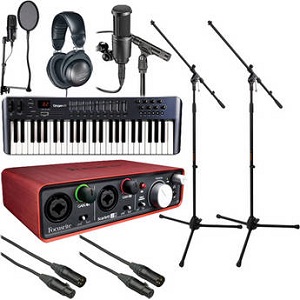From IK Multimedia, the makers of such cool home recording products (we reviewed the iRig Mic recently here: https://www.homebrewaudio.com/pqo) as the iRig Mic and the iKlip (mic and iPad stand for iPhone, iPad and iPod Touch) have just announced the iKlip MINI. See below for details.
IK Multimedia introduces iKlip™ MINI
The universal microphone stand adapter for iPhone® and iPod touch®

iKlip MINI is made of sturdy, durable thermoplastic and is compatible with every existing iPhone and iPod touch, from the original models to the latest generation devices. iKlip MINI firmly holds the device in place in both horizontal and vertical positions, and its multi-angle adjustable design allows for optimal viewing and accessibility to all controls, buttons, connection ports and camera free from obstruction. It can also be easily rotated from portrait to landscape position by simply loosening or tightening a knob with no need for additional tools. It can be mounted on the vertical pole of a mic stand as well as on its horizontal boom.

Users of another popular IK Multimedia mobile device accessory, iRig, can use their guitar interface adapter with the iKlip MINI with the included detachable bracket support. This makes iKlip MINI the perfect accessory for the AmpliTube range of apps or any other guitar effects app.

Other apps for iPhone/iPod touch can also benefit from the iKlip MINI’s support for floor or tabletop mic stands including karaoke, score and tablature, DJ, recording, mixing, video, photography, teleprompting and many more.
For more info: iKlip MINI
Home Recording Equipment
Best "Home Recording Answer" on Yahoo! Answers
HBA Yields “Best Home Recording Answer” on Yahoo! Answers – that’s what we like to see!
Here is what appeared (again:)) today on Yahoo! Answers regarding home recording questions:
Resolved Question
Should I use USB or Line-in For Vocal Recording?
Best Answer – Chosen by Asker
NAMM University Schedule Announced For 2011 Summer NAMM Show
If you’re into music recording, you should be familiar with NAMM, the National Association of Music Merchants. According to their site at: http://www.namm.org NAMM is the not-for-profit association that unifies, leads and strengthens the $17 billion global music products industry.
NAMM scheduled its educational session, NAMM Universtiy, just before its upcoming show to be held at Nashville, Tennessee, during mid July this year. As a prelude to this, they’ve organized a ‘Breakfast Session’ starting with a free breakfast, presentations, discussions etc, affecting musical retailers today. This will be followed by an educational session for feature presentations from musical retailers. This year’s sessions will offer technological sessions based on Google usage. Later sessions will suggestions to focus on changes happening within industry to survive and thrive within industry etc, would help musical bands/groups survive better.
Read the full article here:
NAMM University Schedule Announced For 2011 Summer NAMM Show
Your Home Recording Headquarters: www.homebrewaudio.com
Running a Virtual Recording Studio
 There isn’t that much difference in 2013 between a traditional recording studio, as in recording onto tape, and a virtual recording studio, where you record directly to a computer. Audio immediately enters into what we might call the virtual realm immediately upon recording. Instead of being held on tape format, audio can literally be beamed through the air and transferred from one box to another. It can also be duplicated and replicated any number of times without losing any fidelity.
There isn’t that much difference in 2013 between a traditional recording studio, as in recording onto tape, and a virtual recording studio, where you record directly to a computer. Audio immediately enters into what we might call the virtual realm immediately upon recording. Instead of being held on tape format, audio can literally be beamed through the air and transferred from one box to another. It can also be duplicated and replicated any number of times without losing any fidelity.The best news of all is that the virtual recording studio is the one that is simultaneously more advanced AND more affordable. In fact, odds are incredibly high that you already own a virtual recording studio. If you have a computer with a sound card and any kind of microphone, then your virtual recording studio is probably sitting in a room in your house, or on your laptop.
Just a few years ago, that kind of home recording studio would not have been quite enough to yield professional quality audio. But today, with the availability of unbelievably affordable (some ever free!) recording software (Audacity, Reaper, Adobe Audition, or n-Track Studio just to name a few) and USB microphones (such as the Samson Q1U, Samson G-Track or Blue Yeti), professional sound audio is achievable for just about anyone with a computer, or even a smart phone now!
At the risk of over-simplifying it, the process goes something like this:
- Open your recording software that might have cost you anywhere between $0 and $50 to start out with.
- Speak, sing, or play an instrument in front of a microphone that is hooked up to your computer via a USB cable (or to your iPhone, iPad, or iPod touch if you have the IK Multimedia iRig Mic!).
- Save your finished song, voice-over, or whatever audio you were recording.
- Done.
Speed, quality and ease are the benefits of the virtual recording studio. And if you are collaborating with others on a project involving audio, there is no better way to do it than virtually. Say you need someone with that movie-announce voice to do the intro and “outtro” of your podcast or radio show. Just send that person (if you don’t know them already, you can hire them from places like Voices.com…all in cyberspace) the script via e-mail. They record your script and send it back to you via e-mail. Now all you have to do is insert the movie-announcer voice into your recording software, put some royalty-free background music behind it (or even music you composed and recorded), and voila, you have a professional podcast or radio show introduction and closer, all done in the virtual world; no tapes or CDs to mail back and forth, etc.
Of course you can do the same thing with music. Is your singer in Washington, your other singer in London, and your bass player in Los Angeles? No problem. Send them all an audio file of the demo song over the internet, have them record their parts and e-mail them back to you, then mix it all together into a final song. Your band may never have even seen each other during recording! How amazing is that?
If you’d like to investigate the virtually (no pun intended) limitless audio possibilities of a virtual recording studio, come visit Home Brew Audio on the web. Who knows? A new career may be in the offing with the virtual recording studio you may not even know you already had.
What Do I Need To Record Music At Home?

A version of this question is asked every day. Today on Yahoo! Answers, somebody asked a pretty common question, which was:
Q: I’d like to set up a home studio so I can record guitar parts and maybe vocal parts, and I want them to have really good sound quality. What would I need to do this?
Here is how we answered the question:
A: Hi Chris, Definitely go download Reaper (by Cockos). It’s free for the 60-day trial period (yup – I said “60 days”) and then only $60 if you want to buy a license. That is until you start making 10-20-grand a year with it, at which point they prefer you buy the $220 “commercial license.” But it’s all the same exact software. These guys are awesome. Oh, and their forum is super active. Questions are usually answered within 24 hours by several people.
Anyway, that’s your software. As for the mic, don’t start out with a big expensive mic. I say try out a USB mic (like the Samson Q1U) for about $49. That way you won’t need a separate interface box to plug a normal mic into. If you’re not happy with that, then I recommend a small-diaphragm condenser mic (I use a Shure SM-81) along with an audio interface like the Avid Fast Track. My personal interface is a Focusrite Scarlett 2i2, and has been for the last few years. I love it.
It might help to take a look at our 5-part post series called “How to Build A Home Recording Studio” here.
Hope that helps!
[update 2017] Since writing that, I have some more resources that I would have included for this answer. Those include two home recording started kits/bundles that B&H Photo-Video-Audio put together according to our specs. You can read the details about those two bundles here:
Basic Home Recording Starter Bundle
The Home Recording Musicians Starter Bundle
Ken
Home Brew Audio